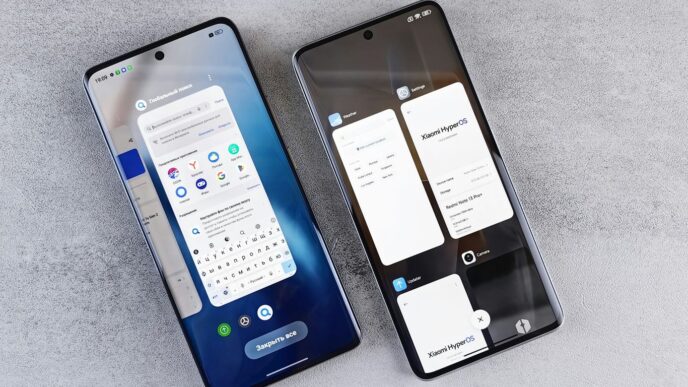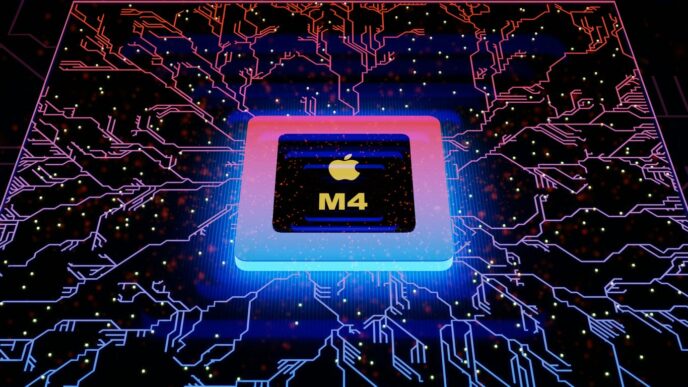Fast Company just dropped its list of the next big things in tech for 2025, and wow, it’s a peek into what’s coming. It’s not just about cool gadgets, but real tech that’s going to change how we work and live. We’re talking about AI shaking up sales, making movies easier to create, and even stopping shoplifting. Plus, cybersecurity is getting a serious upgrade. It’s a look at the innovations that are really going to make a difference.
Key Takeaways
- Gong’s Revenue AI is changing how sales teams work by using AI to understand customers better and boost sales.
- Autodesk Flow Studio is making advanced movie effects more accessible for creators using AI.
- Toshiba’s ELERA® Security Suite uses AI to help stores prevent theft and make shopping better.
- Cybersecurity is shifting to stop threats before they happen, not just after, with new AI tools.
- Fast Company’s picks show a trend towards AI and smarter tech solving big problems across different industries.
Fast Company’s Next Big Thing In Tech: AI Revolutionizing Industries

This year, Fast Company’s ‘Next Big Things in Tech’ list really shines a light on how artificial intelligence is shaking things up across different business sectors. It’s not just about futuristic gadgets anymore; AI is actively changing how companies operate and grow, right now. We’re seeing some seriously smart applications that are setting new benchmarks.
Gong’s Revenue AI Platform Sets New Standards
Gong’s platform is making waves in how businesses handle sales and customer interactions. They’ve built an AI system that looks at all your customer conversations – calls, emails, you name it – and pulls out useful information. This helps sales teams figure out what’s working and what’s not, so they can do better. It’s like having a super-smart coach for your entire revenue department.
Here’s a quick look at what Gong’s AI does:
- Analyzes Customer Interactions: It listens to calls and reads emails to understand customer sentiment and key discussion points.
- Provides Actionable Insights: It tells sales reps and managers what they should do next to close deals or improve relationships.
- Automates Workflows: It can even handle some tasks automatically, freeing up people to focus on building connections.
Autodesk Flow Studio Empowers Media and Entertainment Creators
For those in the media and entertainment world, Autodesk’s Flow Studio is a game-changer. It’s making advanced visual effects (VFX) and animation tools much more accessible. Think about it: indie filmmakers or even social media creators can now use professional-level AI tools without needing a huge budget or a team of specialists.
Key features making Flow Studio stand out:
- AI-Powered Motion Prediction: Accurately guesses how an actor will move in a scene, saving a lot of manual work.
- Wonder Tools: A collection of AI models designed to speed up common creative tasks, cutting down on the need for lengthy production processes.
- Simplified VFX Tasks: Automates complex jobs like motion capture and camera tracking, letting creators focus on the story.
Toshiba’s ELERA® Security Suite Tackles Retail Challenges
Retailers are facing a lot of security issues, especially with things like theft and fraud. Toshiba’s ELERA Security Suite is stepping in to help. It uses AI to spot and stop problems before they even happen, which is a big deal for keeping stores safe and making sure shoppers and employees have a good experience.
This suite focuses on:
- Proactive Shrinkage Prevention: Identifying potential losses from theft or errors before they occur.
- Improved Customer and Staff Experience: Making the shopping environment safer and more efficient.
- On-Device AI Processing: Using edge AI means sensitive data stays local, improving security and speed for decision-making right at the point of sale.
The Future of Revenue Intelligence with Gong
It feels like just yesterday we were talking about basic CRM systems, and now? We’re looking at AI completely changing how sales teams operate. Gong is right at the forefront of this, and honestly, it’s pretty wild to see.
Transforming Revenue Teams with AI-Powered Insights
Think about it: your sales team is out there talking to customers all day. What if you could actually learn from every single one of those conversations, not just the highlights? That’s what Gong’s platform does. It listens in (with permission, of course) and then uses AI to figure out what’s working and what’s not. It’s not just about recording calls; it’s about making sense of the noise. This means managers can actually coach their teams better because they have real data, not just hunches. Sales reps get tips on what to say next, which is a game-changer when you’re trying to close a deal.
- Real-time coaching prompts for sales reps.
- Automated summaries of customer calls.
- Identification of key customer needs and objections.
Driving Growth Through Customer Understanding
Understanding your customer is key, right? But it’s hard to get a clear picture when you’re dealing with so many interactions. Gong’s AI helps connect the dots. It can spot trends in what customers are asking for, what their pain points are, and even how they’re reacting to different pitches. This kind of deep insight helps companies not just sell better, but also build better products and services. It’s about making smarter decisions based on what people are actually saying. This is how you really drive growth, by knowing your market inside and out. It’s a big shift from just guessing what customers want.
Unveiling New Innovations in Revenue AI
Gong isn’t resting on its laurels. They’re constantly pushing the boundaries of what revenue AI can do. They’ve introduced things like Gong Orchestrate, which is designed to seriously boost how productive revenue teams are. The goal is to make reps way more efficient and speed up how quickly deals get done. This isn’t just about incremental improvements; it’s about fundamentally changing the game for how businesses grow. They’re looking at AI agents that can handle complex tasks, freeing up people to focus on building relationships and closing deals. It’s exciting to see what they’ll come up with next, especially with how fast AI is moving. You can check out some of their latest work in revenue AI and see how it’s shaping the future.
Innovations Shaping the Media and Entertainment Landscape
The world of media and entertainment is changing fast, and a lot of that has to do with new tech making things easier and more creative. Think about visual effects (VFX) for movies or TV shows. For years, creating those amazing scenes required huge teams and budgets that only big studios could afford. But that’s not the case anymore.
Accessible AI-Powered Visual Effects for All Creators
Autodesk’s Flow Studio is a big part of this shift. It’s designed to put professional-level AI tools right into the hands of creators, no matter if they’re making a blockbuster or a YouTube video. This means more people can bring their visual ideas to life without needing a massive budget or a specialized degree. It’s about making complex tools simple to use. This democratization of VFX is a game-changer for independent filmmakers and content creators everywhere.
Redefining Low-Cost Visual Effects with Key Features
Flow Studio has been adding features that really shake things up in the low-cost VFX space. They’ve got things like Motion Prediction, which uses AI to figure out how an actor will move in a scene, making animation smoother. Then there are the Wonder Tools, a growing set of AI models that speed up workflows by cutting out parts of the traditional live-action or animation process. They even support MetaHuman, which is pretty neat for creating realistic characters. These tools help creators focus on the story, not just the technical headaches.
Automating Complex VFX Tasks for Enhanced Storytelling
What Flow Studio does so well is take on the really tough, time-consuming VFX jobs. Things like motion capture, camera tracking, and character animation can be automated using AI. This lets creators stay in charge and concentrate on what matters most: telling a great story. You can take a simple video clip, add computer-generated characters, and render it out, all with just a few clicks. It really opens up possibilities for anyone with a story to share, making advanced 3D animation and VFX accessible to a much wider audience. This kind of innovation is a big reason why we’re seeing key trends for 2025 in media and entertainment emerge, with AI playing a central role.
Advancing Retail Operations with AI
Retailers are facing some pretty big headaches these days, and one of the most persistent is something called ‘shrinkage’ – basically, lost merchandise. It’s a complex problem, often a mix of things like human error, processes that aren’t quite right, and systems that just don’t talk to each other well. Toshiba’s ELERA® Security Suite is stepping in with a new approach, using AI to try and fix this before it even becomes a problem.
Proactive Prevention of Retail Shrinkage
Instead of just trying to catch thieves after the fact, ELERA® aims to stop losses before they happen. It works by looking at what’s going on in the store in real-time. Think of it like a helpful assistant that guides both shoppers and staff. If something looks like it might lead to a loss, the system can step in. This isn’t about being intrusive; it’s about making sure things run smoothly and accurately. The goal is to catch potential issues early, like a misplaced item or a transaction that’s not quite right, and nudge things back on track.
Enhancing Shopper and Associate Experiences
This AI isn’t just about preventing loss; it’s also about making the shopping experience better for everyone. By reducing errors and streamlining processes, it can make checkout faster and less frustrating. For associates, it means less time spent dealing with problems and more time helping customers. It’s about creating a more positive environment for both sides of the counter.
Edge AI for Secure, On-Device Decision-Making
One of the smart parts of ELERA® is how it uses ‘edge AI’. This means the AI processing happens right there on the device in the store, not somewhere far away in the cloud. This is a big deal for security and speed. Decisions can be made instantly, without sending sensitive data over the internet. This keeps things private and makes the system respond much faster, which is exactly what you need when you’re trying to prevent a problem on the spot.
Preemptive Cybersecurity: A New Era of Digital Defense
It feels like every week there’s a new headline about a massive data breach or a sophisticated scam. The old ways of just reacting after something bad happens aren’t cutting it anymore. We’re talking about a whole new approach now, one that tries to stop trouble before it even starts. This isn’t just about being a little faster; it’s about fundamentally changing how we think about digital safety. The future of cybersecurity lies in anticipating and neutralizing threats before they can impact systems.
Detecting and Disrupting Threats Before Login
Most security tools wait until a login attempt is already in progress, or even after credentials have been submitted. That’s too late. The real danger often begins much earlier, during those tricky redirects or when fake websites pop up. Think about it: by the time your bank’s system flags a suspicious login, the scammer might have already gotten what they needed. This is where preemptive cybersecurity steps in. It looks for those early warning signs, like suspicious device behavior or fake login pages, and shuts things down before any real damage can be done. It’s about getting ahead of the game, not just playing catch-up. This proactive stance is a big reason why companies are looking at new solutions to stay ahead of cyber risks.
Combating Phishing and Account Takeover Attempts
Phishing and account takeovers (ATO) are getting smarter. Scammers are using advanced tools to create fake sites that look incredibly real, tricking people into giving up their usernames and passwords. Traditional defenses often miss these because they activate too late. Preemptive solutions, however, can do things like inject fake credentials into phishing forms, making any harvested data useless. They can also track devices to spot suspicious activity, even before a login is attempted. This means legitimate users get a smooth experience, while potential threats are flagged and stopped.
Here’s a look at how these new methods work:
- Early Signal Detection: Identifying threats during redirects and fake site loads, not just at the login screen.
- Decoy Data Injection: Automatically feeding fake credentials into phishing forms to spoil harvested data.
- Persistent Device ID: Recognizing suspicious devices even across different sessions, before any login occurs.
- Impersonation Monitoring: Watching for fake apps, ads, and social media accounts trying to impersonate legitimate brands.
The Shift from Reactive Detection to Proactive Disruption
For years, the cybersecurity industry focused on detecting threats after they had already breached defenses. This reactive model is proving insufficient against today’s fast-moving, automated attacks. The shift is towards disruption. Instead of just identifying a threat, the goal is to actively interfere with the attacker’s plan. This might involve confusing their tools, scrambling stolen information before it can be used, or identifying exactly who and what is being targeted in real-time. This proactive disruption is what sets the new era of digital defense apart, moving from simply spotting problems to actively preventing them from ever succeeding. It’s a smarter, more effective way to protect digital assets and user trust. Companies are seeing real results, like a significant reduction in ATO incidents and millions saved in fraud losses, by adopting this forward-thinking approach. This move towards prevention-first models is a clear signal of where the industry is headed.
Understanding Fast Company’s Vision for Tech
So, what’s the big idea behind Fast Company’s picks for the next big things in tech? It’s not just about shiny new gadgets or software that sounds cool. They’re really looking for innovations that are going to shake things up, you know? It’s like they have a crystal ball for future technological advancements, trying to spot the stuff that will actually change how we live and work.
They focus on recognizing visionary innovation and industry impact. This means they’re not just picking things that are technically impressive; they want to see how these technologies will make a real difference. Think about it: they’re looking at how businesses are using new ideas, how companies are pushing boundaries, and how design plays a role in all of it. It’s all about that intersection of business, innovation, and design.
Here’s a breakdown of what they seem to value:
- Real-world application: Does it solve a problem or create a new opportunity?
- Forward-thinking: Is it a glimpse into what’s next, not just what’s now?
- Industry disruption: Does it have the potential to change how an entire sector operates?
- Scalability: Can it grow and affect a lot of people or businesses?
Fast Company is essentially highlighting technologies that are poised to redefine industries and improve lives over the next five years. They’re not just reporting on current trends; they’re trying to predict the future. It’s a way to see what’s coming down the pipeline and understand the forces shaping our world. For instance, advancements in vision care are becoming more integrated with overall health detection, showing how different fields are starting to connect through new technologies.
It’s a pretty neat way to look at the tech landscape, focusing on the companies and ideas that are truly making waves and setting new standards for what’s possible.
Looking Ahead
So, that’s a peek at what Fast Company sees as the next big tech trends for 2025. It’s pretty wild to think about how fast things are changing, right? From making movies with AI to stopping scams before they even start, these companies are really pushing boundaries. It makes you wonder what else is just around the corner. One thing’s for sure, keeping up with tech is a full-time job, but it’s also kind of exciting to see what these innovators are cooking up. We’ll have to wait and see which of these actually change the world, but it’s definitely worth keeping an eye on.
Frequently Asked Questions
What is Fast Company’s ‘Next Big Thing in Tech’ list all about?
Fast Company’s ‘Next Big Thing in Tech’ list is like a sneak peek into the future of technology. It highlights cool new inventions and ideas that are expected to make a big difference in the coming years, changing how we live and work.
How does AI help companies like Gong make more money?
Gong uses a special type of AI, called Revenue AI, to help sales teams understand their customers better. It listens to conversations and finds important information that helps teams sell more effectively and grow the business.
What’s new with Autodesk Flow Studio for movies and games?
Autodesk Flow Studio makes it easier for anyone to create amazing special effects (VFX) for movies and games using AI. It helps with tricky tasks like making characters move realistically, so creators can focus on telling their stories.
How is Toshiba’s ELERA® Security Suite helping stores?
Toshiba’s ELERA® Security Suite uses AI to help stores prevent shoplifting and mistakes. It works with devices right there in the store to make smart decisions quickly, making shopping better for customers and easier for employees.
What does ‘preemptive cybersecurity’ mean?
Preemptive cybersecurity is like stopping a problem before it even starts. Instead of just catching bad guys after they’ve already done something, it looks for signs of trouble early on and stops the attack before it can cause harm.
Why is understanding customer interactions important for businesses?
Knowing what customers are saying and what they need is super important. By paying attention to these interactions, businesses can learn how to make their products better, improve their service, and build stronger relationships with their customers.













